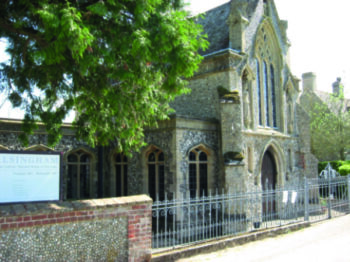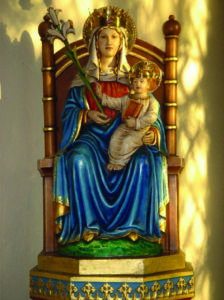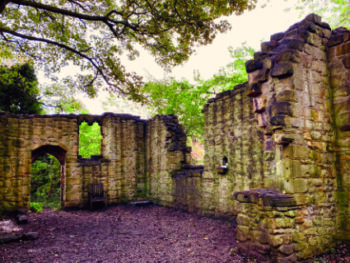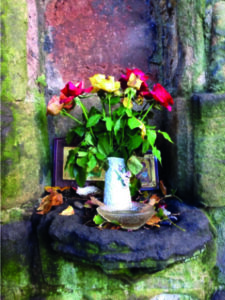The Story of Two English Shrines

By John Ewen
From August this year, New Zealand will have a National Shrine of our Lady; it will be in St Mary of the Angels in Wellington, a beautiful church staffed by Marist priests and a fitting place. We hope and pray that it will become a place of devotion and consolation for all.

The Slipper Chapel, National Shrine of Our Lady of Walsingham
It is worth noting that shrines in honour of Our Lady are well established overseas: Wikipedia names 64 countries, including such unexpected ones as Turkey, Indonesia, Syria and China where they can be found. The University of Dayton, Ohio lists 18 in England today.
Such places of veneration of Our Lady were once widespread throughout the British Isles from Anglo-Saxon times until the reign of King Henry VIII. There are many records of English kings and queens (including Henry himself) visiting Marian shrines, often making endowments or other gifts to them. In fact England was considered to be ahead of the rest of Europe in such devotion, and many pilgrims came from the Continent, often spending weeks walking through the country to visit each in turn.
That all ended when Henry turned against the church. The monasteries were destroyed or given to his followers, priests were hunted down and killed publicly in excruciating ways, and the laity were forced to adhere to his new church or suffer death or severe penalties. Devotion to Mary was particularly targeted, and her shrines were destroyed and many statues and other images of her were taken to Thomas Cromwell to be burnt publicly in London.
Those faithful to Catholicism, including the veneration of Mary, had to practise their religion in the utmost secrecy or suffer death or severe penalties. Gradually, restrictions were eased but it was 400 years before the Catholic Church was decriminalised and could own property again. Over time, some Marian shrines were reinstated, but not always on the same site. Some are widely known today and attract huge numbers of people. Others not so. Here are two examples:
The National Shrine of Our Lady of Walsingham
 Located in a remote rural part of north Norfolk, where in 1061, a pious noble-woman, Richeldis de Faverches experienced several visions of the Blessed Virgin who asked her to build a replica of the house in which she experienced the Annunciation. Richeldis built the structure in Walsingham village, Her son then built a priory and the Shrine became one of the most important Marian places in medieval Europe, and with Canterbury and Glastonbury, one of the three greatest religious sites in England. It was totally destroyed in 1538 by Thomas Cromwell’s forces.
Located in a remote rural part of north Norfolk, where in 1061, a pious noble-woman, Richeldis de Faverches experienced several visions of the Blessed Virgin who asked her to build a replica of the house in which she experienced the Annunciation. Richeldis built the structure in Walsingham village, Her son then built a priory and the Shrine became one of the most important Marian places in medieval Europe, and with Canterbury and Glastonbury, one of the three greatest religious sites in England. It was totally destroyed in 1538 by Thomas Cromwell’s forces.
However, a mile away the Slipper Chapel, built in 1340, survived but was used as a barn for centuries. It was so called because pilgrims would take off their footwear to walk barefoot to the Shrine in the village. In 1896 a convert, Miss Charlotte Pearson Boyd, bought the Chapel and began restoring it, and in 1897, Pope Leo XIII blessed an image of the Virgin for the chapel which, with his permission, became the site for the Shrine to be re-established. It soon began attracting the faithful in large numbers. In 1982, a large Chapel of Reconciliation was consecrated. It can hold 500 and can be opened out to the Shrine grounds so that several thousand can attend Mass together. Many thousands come any summer weekend.
It can be said that the Walsingham Shrine exists today because of three women: Our Lady, Richeldis de Faverches who acted on the vision she was given, and Charlotte Boyd who took it upon herself to recover the sole remaining medieval link – the Slipper Chapel and undertake its restoration.
Our Lady of Walsingham is also venerated within the Anglican Church. In 1931, an Anglican vicar, Fr Hope-Patten, installed a statue of Our Lady in the church in the village, and to the consternation of the Bishop of Norfolk, many thousands of Anglicans began to visit, so the church had to be enlarged in 1938, 400 years to the year after the original shrine was destroyed. Even though Walsingham is a small village, the two Shrines were attracting over a quarter of a million people every year before Covid-19; many people visiting both places. Both shrines have comprehensive websites if you search ‘Our Lady of Walsingham.’
There is much evidence that in medieval times there was deep devotion to Our Lady, and King Richard II, in times of trouble in 1381, entrusted the country to the Blessed Virgin, saying England was the Dowry of Mary. Pope Leo XIII referred to this description when giving his blessing to the Walsingham Shrine, and on 29 March 2020, 530,000 people in England and around the world tuned in to the livestream to pray the rededication of England to Mary by the English Catholic Bishops at Walsingham.
The Shrine of Our Lady of Jesmon
It is in a wooded area a mile from the centre of Newcastle-upon-Tyne, an industrial city in Northumberland. It too, became a place of pilgrimage in the 11th century, perhaps even before the Norman Conquest. It is not clear now how it became established; there is a suggestion of a tradition that Mary, holding the baby Jesus, appeared on a rock in the area. The earliest document still existing that refers to the chapel is dated in the 12th century and as pilgrims began flocking to it, the chapel was extended in the 14th century. Even now, one of the main business streets in Newcastle is called Pilgrim Street.
Still existing in the Vatican records today is a Papal Rescript issued by Pope Martin V in 1428 referring to the miracles at Jesmond, the numbers of pilgrims, and granting indulgences to penitents visiting the Shrine on certain Holy Days. They were dangerous times for pilgrims: on foot, travelling the length of England on poor roads with no amenities, and roving bands of robbers preying on them. A Yorkshire rector writing in 1479 referred to Our Lady of Jesmond Shrine as ‘one of the greatest in the Kingdom’ ranking alongside Canterbury and St Paul’s. A hospital was built for ill and dying pilgrims near the Chapel but nothing of it survives today. St Mary’s Well, reputed to have healing powers, is nearby, but was remodelled in Victorian times as a spring of fresh water.

The ruins of the Chapel of Our Lady of Jesmond
As elsewhere, under Henry VIII’s Dissolution of the Monasteries decree, the Shrine was stripped of valuables and the Chapel was left in ruins. The land on which it stands passed through several private owners before it and Jesmond Dene, a wooded valley, were acquired by a local wealthy industrialist, Lord Armstrong, who in 1883 presented it to the Newcastle City Council, which still owns it and requires its permission to be given for any religious celebration there. 
So, in complete contrast to Walsingham, the Catholic Church in modern times has not actively involved itself with it as a shrine on a regular basis, though from time to time there have been diocesan pilgrimages (e.g. 4000 people attended on 29 April 1956) with Mass being said in the ruined chapel grounds. Each year still, a small group of Jesmond parishioners and others gather to pray at the Chapel ruins. The devotion to the Blessed Virgin is still alive there even if it is nothing compared to the immense popularity of the National Shrine. I lived two streets away from the Jesmond site for some years, and I knew that someone constantly placed fresh flowers there.
And as a Mr T.W. Airey says, in his foreword to the 5th edition of Fr. David Costar’s booklet ‘The Shrine of Our Lady of Jesmond,’ “Our Blessed Lady is still there, waiting…”
John Ewen is a parishioner of Our Lady of Kāpiti.
 Entries(RSS)
Entries(RSS)